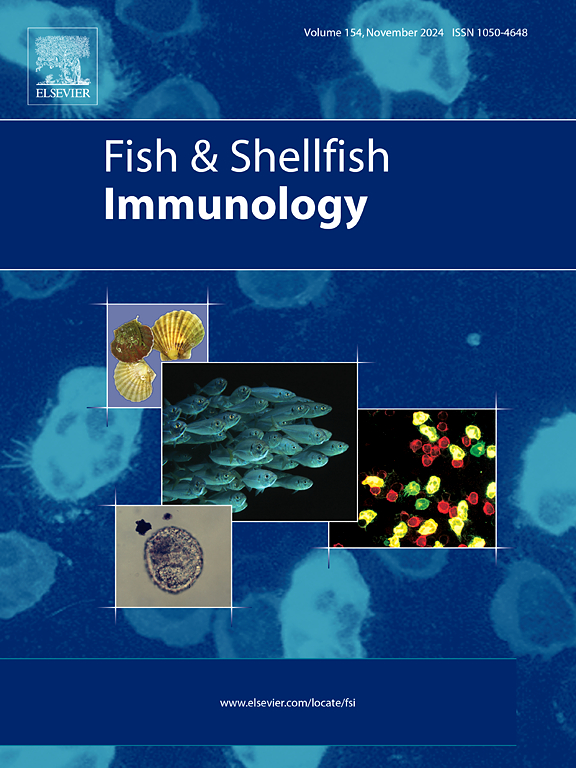Vibrio harveyi uses both type III secretion system and quorum sensing for the colonization of the European abalone
IF 4.1
2区 农林科学
Q1 FISHERIES
引用次数: 0
Abstract
The vibriosis of the European abalone, Haliotis tuberculata, is characterized by the rapidity of the infection by the pathogen Vibrio harveyi ORM4, leading to death of animals only after two days. The lethality of the pathogen is linked to the production of the type III secretion system (T3SS) and to genes regulated by quorum sensing (QS). The aim of this study was to investigate the colonization of the European abalone by both virulent and avirulent V. harveyi strains, as well as the involvement of T3SS and QS during infection. Our results emphasize the importance of gills for the bacterial establishment as the bacterial concentration of the avirulent V. harveyi strain significantly decreased from 189.3 ± 98.6 CFU/mg to 0.8 ± 0.5 CFU/mg between 24 and 48 h post-infection (hpi). In opposition, the pathogen V. harveyi ORM4 was able to maintain itself on the gills, with a concentration of 461.9 ± CFU/mg at 48 hpi, which was allowed by the production of T3SS and a functional QS. Following the infection cycle of V. harveyi ORM4 inside H. tuberculata, we also demonstrated that QS is essential for the ability of V. harveyi ORM4 to colonize the abalone hemolymph and to maintain in it. In response to the presence of V. harveyi, an increase in reactive oxygen species production was recorded, while the phagocytosis activity remained unchanged. We also highlighted the involvement of both QS and T3SS to escape the immune system activity, and that an overproduction of T3SS induced hemocyte mortality. This study provides the evidence that both T3SS and QS are essential for the establishment of V. harveyi ORM4 inside the European abalone.
哈维氏弧菌利用 III 型分泌系统和法定量感应在欧洲鲍鱼中定植。
欧洲鲍鱼的弧菌病,结核鲍鱼,其特点是被病原体哈维弧菌ORM4感染迅速,导致动物仅在两天后死亡。病原体的致命性与III型分泌系统(T3SS)的产生和群体感应(QS)调节的基因有关。本研究的目的是研究强毒株和无毒株在欧洲鲍鱼中的定殖情况,以及T3SS和QS在感染过程中的作用。我们的研究结果强调了鳃对细菌建立的重要性,因为在感染后24至48小时(hpi),无毒哈维伊弧菌的细菌浓度从189.3±98.6 CFU/mg显著下降到0.8±0.5 CFU/mg。相反,harveyi V. ORM4能够在鳃上维持自身,48 hpi时的浓度为461.9±CFU/mg,这是由T3SS和功能QS的产生所允许的。通过对V. harveyi ORM4在结核分枝杆菌内的感染周期研究,我们也证实了QS对V. harveyi ORM4在鲍鱼血淋巴中的定殖和维持能力至关重要。结果表明,在V. harveyi存在的情况下,活性氧产量增加,而吞噬活性保持不变。我们还强调了QS和T3SS都参与逃避免疫系统活动,并且T3SS的过量产生诱导血细胞死亡。本研究提供了T3SS和QS对欧洲鲍鱼体内harveyi V. ORM4的建立至关重要的证据。
本文章由计算机程序翻译,如有差异,请以英文原文为准。
求助全文
约1分钟内获得全文
求助全文
来源期刊

Fish & shellfish immunology
农林科学-海洋与淡水生物学
CiteScore
7.50
自引率
19.10%
发文量
750
审稿时长
68 days
期刊介绍:
Fish and Shellfish Immunology rapidly publishes high-quality, peer-refereed contributions in the expanding fields of fish and shellfish immunology. It presents studies on the basic mechanisms of both the specific and non-specific defense systems, the cells, tissues, and humoral factors involved, their dependence on environmental and intrinsic factors, response to pathogens, response to vaccination, and applied studies on the development of specific vaccines for use in the aquaculture industry.
 求助内容:
求助内容: 应助结果提醒方式:
应助结果提醒方式:


